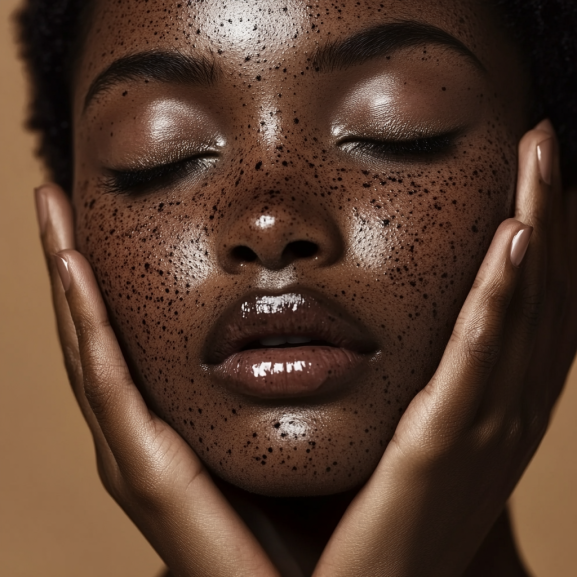
Unlock Your Glow
Hyperpigmentation. The word itself can send shivers down our spines. It’s like that uninvited guest who just won’t leave the party. For many black women, hyperpigmentation isn’t just a fleeting issue it’s a recurring character in our skincare stories.
Let’s face it, our skin is beautiful and unique, but it’s also prone to certain challenges. Hyperpigmentation is one of them. But fear not! If you’ve been battling those stubborn dark spots, uneven skin tone, or patches of discolored skin, you’re not alone. Today, we’re diving into the heart of the matter: how to treat hyperpigmentation effectively, especially tailored for beautiful black skin.
Understanding Hyperpigmentation: Why Us?
First things first, let’s break down what hyperpigmentation really is. Hyperpigmentation refers to areas of skin that become darker than the surrounding skin. This can happen due to an overproduction of melanin, the pigment that gives our skin its rich, beautiful hue. And here’s the kicker our gorgeous melanin-rich skin, while fabulous, is also more prone to hyperpigmentation. It’s a double-edged sword. On the one hand, melanin offers protection against sun damage; on the other hand, when our skin is wounded whether from acne, cuts, or inflammation it can result in these pesky dark spots. Pregnancy, puberty, and menopause can all cause hormonal fluctuations that affect pigmentation. Certain medications, such as birth control pills or antibiotics, can sometimes cause hyperpigmentation as a side effect. In some cases, hyperpigmentation can be inherited—genetic predisposition.
Personal Story Time: My Battle with Hyperpigmentation
Let me take you back a few years. I was fresh out of college, juggling multiple part-time jobs, and stressing over life in general (hello, adulting!). My skin, already oily and prone to breakouts, decided to stage a full-on rebellion. I ended up with more hyperpigmentation than I cared to count. I tried everything under the sun from home remedies my grandma swore by (thanks, but no thanks, lemon juice) to over-the-counter products that promised the moon but delivered little more than a lighter wallet.
Eventually, I discovered a few game-changing strategies. And that’s what I’m here to share with you—a roadmap to smoother, more even-toned skin without losing your sanity or breaking the bank.
The Science of Skin: Why It Matters
Before we get into the nitty-gritty of how to treat hyperpigmentation, let’s touch on some science (because, ladies, we deserve to know what’s happening beneath the surface). According to dermatological studies, hyperpigmentation in black skin can be particularly stubborn due to the skin’s response to inflammation and injury. When the skin is damaged, melanocytes (the cells responsible for melanin production) can go into overdrive, producing more pigment in response to perceived threats. This results in those darker spots we all know too well.
Moreover, black women often deal with post-inflammatory hyperpigmentation (PIH), which occurs after an inflammatory wound or condition, like acne or eczema. It’s crucial to approach treatment with a mix of patience, consistency, and, most importantly, the right products and practices.
Your Ultimate Guide on How to Treat Hyperpigmentation
1. Sunscreen, Sunscreen, Sunscreen!
Yes, I know what you’re thinking: “Sunscreen? Really?” But hear me out. This is the number one rule in treating hyperpigmentation. Sunscreen is your best friend. You see, UV rays can worsen hyperpigmentation, making those dark spots even darker. And don’t think for a second that black skin doesn’t need sunscreen this is a myth that needs to go!
Opt for a broad-spectrum sunscreen with at least SPF 30. The best part? There are now so many sunscreens formulated specifically for darker skin tones, so no more looking ashy or chalky. Look for sunscreens containing zinc oxide or titanium dioxide, as they are less likely to cause irritation.
2. Incorporate Vitamin C Into Your Routine
Vitamin C is like the Beyoncé of skincare ingredients – powerful, effective, and universally loved. It’s a potent antioxidant that helps brighten the skin and fade dark spots by inhibiting melanin production. Plus, it protects your skin against free radicals and environmental stressors. When choosing a Vitamin C serum, go for one with a concentration of 10-20%. Apply it in the morning before your sunscreen to maximize its protective benefits.
3. Exfoliation: The Gentle Art
We’ve all been tempted by those grainy scrubs that feel like they’re “doing something,” right? But here’s the scoop: for black women, harsh scrubbing can exacerbate hyperpigmentation by irritating the skin. Instead, opt for chemical exfoliants like AHAs (alpha hydroxy acids) and BHAs (beta hydroxy acids). These gentle exfoliants help slough off dead skin cells, revealing brighter, more even-toned skin beneath without causing trauma.
Look for products containing glycolic acid, lactic acid, or salicylic acid. Start slow maybe once or twice a week and see how your skin reacts. Remember, the key is to be gentle!
4. Hydroquinone: The Spot Treatment Star
Hydroquinone is often hailed as the gold standard in treating hyperpigmentation. It works by inhibiting the enzyme responsible for melanin production. However, it’s essential to use this ingredient with caution, especially on sensitive skin. Dermatologists recommend using it for a limited time (typically 3-4 months) and then taking a break to avoid any potential side effects.
For black women, lower concentrations (around 2%) are usually sufficient and safer. Remember, less is more – apply only to the affected areas.
5. Niacinamide: The All-Rounder
If you’re looking for a versatile ingredient that tackles hyperpigmentation and supports overall skin health, niacinamide (Vitamin B3) should be on your radar. It reduces inflammation, minimizes pore appearance, and can even regulate oil production. But, most importantly, niacinamide helps lighten dark spots and improve skin elasticity.
And the best part? It plays well with others. Niacinamide can be layered with other skincare products without causing irritation, making it a perfect addition to any routine focused on treating hyperpigmentation.
6. Retinoids: The Game Changer
Retinoids, derived from Vitamin A, are another powerful weapon in the fight against hyperpigmentation. They increase cell turnover, help fade dark spots, and improve skin texture. But beware—retinoids can be strong, especially for beginners. Start with a lower concentration and apply it at night to avoid photosensitivity. Also, don’t forget to moisturize, as retinoids can be drying.
7. Kojic acid: Similar to Hydroquinone
This natural ingredient derived from mushrooms has been shown to inhibit melanin production and lighten hyperpigmentation. It was first discovered in Japan, derived from a type of fungus (Aspergillus oryzae) that is involved in the fermentation process of rice, specifically in the production of sake (rice wine). Due to its ability to inhibit the production of melanin, kojic acid has become a popular ingredient in products aimed at addressing dark spots, age spots, and uneven skin tone. Kojic acid is commonly found in various skincare products such as soaps, creams, serums, and lotions.
It’s often combined with other skin-lightening agents like glycolic acid, alpha hydroxy acids (AHAs), or retinoids for a synergistic effect.
While kojic acid is generally safe for most people, it can cause some side effects, particularly with prolonged use or use of high concentrations. Common side effects include:
- Skin Irritation: Some individuals may experience redness, itching, or irritation, especially if they have sensitive skin.
- Allergic Contact Dermatitis: In rare cases, kojic acid can cause an allergic reaction, leading to rashes or inflamed skin.
- Increased Sun Sensitivity: Like many skin-brightening ingredients, kojic acid can make the skin more sensitive to the sun. It’s crucial to apply sunscreen regularly when using products containing kojic acid to prevent sunburn and further hyperpigmentation.
It’s always recommended to do a patch test first and consult with a dermatologist, especially if you have sensitive skin or existing skin conditions.
8. Azelaic acid: Alternative to Hydroquinone
It is derived from grains such as barley, wheat, and rye, but it is often synthesized in labs for use in skincare products. Azelaic acid is known for its anti-inflammatory, antibacterial, and exfoliating properties, making it a versatile ingredient in both prescription and over-the-counter skincare formulations. It has the ability to treat a variety of skin conditions, including acne, rosacea, and hyperpigmentation.
Azelaic acid is available in various forms, including gels, creams, and foams, typically at concentrations ranging from 10% to 20%. Prescription-strength azelaic acid products (usually 15% to 20%) are often used for treating more severe cases of acne or rosacea, while lower concentrations are available over the counter. While azelaic acid is considered safe and effective for most people, it can cause mild side effects, especially when you first start using it.
Whether you’re dealing with stubborn breakouts, trying to calm rosacea flare-ups, or working to even out your skin tone, azelaic acid could be the key to achieving clearer, healthier skin. Always remember to introduce new products gradually and consult with a dermatologist if you have any concerns or specific skin conditions.

9. Chemical Peels
Chemical peels involve applying a chemical solution to the skin to exfoliate the top layer and reveal smoother, brighter skin. There are different types of chemical peels, from mild to deep, so it’s important to choose the right one based on your skin type and concerns.
10. Laser Therapy
Laser therapy uses concentrated beams of light to target and destroy excess melanin. This can be an effective option for treating stubborn hyperpigmentation, but it may require multiple sessions.
11. Microdermabrasion
Microdermabrasion is a non-invasive procedure that uses tiny abrasive crystals to exfoliate the skin and improve its texture. It can also help reduce the appearance of hyperpigmentation.
12. Natural Remedies: What Works and What Doesn’t
We all love a good DIY moment, but when it comes to treating hyperpigmentation, it’s best to be cautious. While ingredients like aloe vera, turmeric, and green tea have antioxidant properties, they’re not as potent as clinically proven treatments. However, if you prefer a more natural approach, these ingredients can be great supplements to your skincare routine. Just don’t expect overnight miracles!
A Few Quick Don’ts to Keep in Mind
- Don’t Pick or Squeeze: Picking at your skin can lead to more pigmentation and even scarring. Keep your hands off!
- Avoid Aggressive Treatments: Overusing peels or scrubs can damage your skin and worsen hyperpigmentation.
- Stay Consistent: Treating hyperpigmentation is a marathon, not a sprint. Consistency is crucial.
Additional Tips for Black Women
- Be patient: Treating hyperpigmentation takes time. Don’t get discouraged if you don’t see results immediately.
- Consult a dermatologist: A dermatologist can help you determine the best treatment plan for your specific skin type and concerns.
- Use gentle skincare products: Avoid harsh products that can irritate your skin and worsen hyperpigmentation. Opt for gentle cleansers, moisturizers, and toners.
- Exfoliate regularly: Exfoliation can help remove dead skin cells and reveal a brighter complexion. However, be gentle and avoid over-exfoliating.
Conclusion: Embrace Your Journey to Clearer Skin
Hyperpigmentation can be a frustrating skin condition, but with the right approach, it can be effectively managed. By understanding how to treat hyperpigmentation involves more than just slapping on a few products. It’s about learning your skin, being patient with the process, and embracing the journey to clearer, healthier skin. Remember, patience is key. It may take time to see significant results, but with consistent effort and the right treatment plan, you can say goodbye to hyperpigmentation and embrace your beautiful skin.


